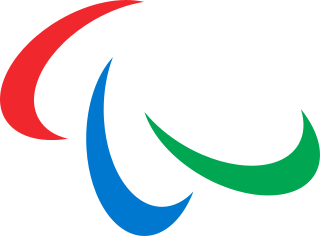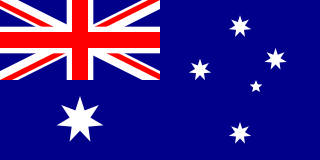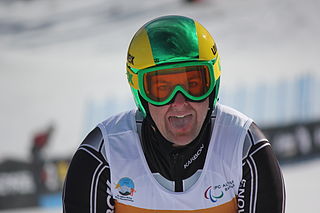Related Research Articles

Paralympic alpine skiing is an adaptation of alpine skiing for athletes with a disability. The sport evolved from the efforts of disabled veterans in Germany and Austria during and after the Second World War. The sport is governed by the International Paralympic Committee Sports Committee. The primary equipment used includes outrigger skis, sit-skis, and mono-skis. Para-alpine skiing disciplines include the downhill, super-G, giant slalom, slalom, super combined, and snowboard.
Paralympic Nordic skiing is a Winter Paralympics sport consisting of biathlon and cross-country skiing. The sport is governed by the International Paralympic Committee, with its subcommittee for Nordic skiing known as World Para Nordic Skiing.

The Winter Paralympic Games is an international multi-sport event where athletes with physical disabilities compete in snow and ice sports. The event includes athletes with mobility impairments, amputations, blindness, and cerebral palsy. The Winter Paralympic Games are held every four years directly following the Winter Olympic Games and hosted in the same city. The International Paralympic Committee (IPC) oversees the Games. Medals are awarded in each event: with gold for first place, silver for second, and bronze for third, following the tradition that the Olympic Games began in 1904.

The 1984 Winter Paralympics, then known as The Third World Winter Games for the Disabled, were held in Innsbruck, Austria. The games took place from the 15 until 21 January. Present at these games were 419 athletes from 21 countries, Spain and the Netherlands competing for the first time in the Winter Paralympics, competing in 107 events across 3 sports. The inclusion of Les Austres and Cerebral palsy impairment groups contributing to the distinct increase in athlete participation with the total number of athletes jumping from 229 at Geilo, Norway in 1980.

The 2011 IPC Alpine Skiing World Championships was held in Sestriere, Italy, from January 14 to 23, 2011. IPC stands for International Paralympic Committee.

The 2011 IPC Biathlon and Cross-Country Skiing World Championships took place from 2–11 April 2011 in Khanty-Mansiysk, Russia. IPC stands for International Paralympic Committee. This was the first time these championships were hosted in Russia, and the first time the championships were hosted in the same city as the IBU Biathlon World Championships which was held in Khanty-Mansiysk from March 3 to March 13, 2011.

Australia sent a delegation to compete at the 1988 Winter Paralympics in Innsbruck, Austria, which was held between 17–24 January 1988. This marked the nation's fourth appearance at the Winter Paralympics. The delegation sent a group of five alpine skiers as they wouldn't get a medal in these games.

Australia competed at the 1992 Winter Paralympics in Tignes and Albertville in France. They were the first winter Paralympics to be celebrated concurrently with the Olympic Games. The official logo of the Games was designed by Jean-Michel Folon. It depicts a bird with broken wings, soaring high across the peak of a mountain. This was used to reflect the sporting abilities of the athletes at the Games. The official mascot, Alpy, designed by Vincent Thiebaut, represented the summit of the Grande Motte mountain in Tignes. Alpy was shown on a mono-ski to demonstrate its athleticism and the colours of white, green and blue were used to represent purity/snow, hope/nature and discipline/the lake. The 1992 Games were where Australia won their first winter medals at the Paralympics. Michael Milton won Australia's first gold with a win in the men's slalom LW2. Milton also won a silver medal in the men's super-G LW2. At these Games, Australia was represented by 5 male athletes. Australia was placed 12th in the overall medal tally for the Winter Games winning a total of 4 medals: 1 gold, 1 silver and 2 bronze.
Para-alpine skiing classification is the classification system for para-alpine skiing designed to ensure fair competition between alpine skiers with different types of disabilities. The classifications are grouped into three general disability types: standing, blind and sitting. Classification governance is handled by International Paralympic Committee Alpine Skiing. Prior to that, several sport governing bodies dealt with classification including the International Sports Organization for the Disabled (ISOD), International Stoke Mandeville Games Federation (ISMWSF), International Blind Sports Federation (IBSA) and Cerebral Palsy International Sports and Recreation Association (CP-ISRA). Some classification systems are governed by bodies other than International Paralympic Committee Alpine Skiing, such as the Special Olympics. The sport is open to all competitors with a visual or physical disability. It is not open to people with intellectual disabilities.

Para-Nordic skiing classification is the classification system for para-Nordic skiing which includes the biathlon and cross-country events. The classifications for Para-Nordic skiing mirrors the classifications for Para-Alpine skiing with some exceptions. A functional mobility and medical classification is in use, with skiers being divided into three groups: standing skiers, sit skiers and visually impaired skiers. International classification is governed by International Paralympic Committee, Nordic Skiing (IPC-NS). Other classification is handled by national bodies. Before the IPC-NS took over classification, a number of organizations handled classification based on the type of disability.
LW12 is a para-alpine and para-Nordic sit skiing sport class defined by the International Paralympic Committee (IPC). An LW12 skier needs to meet a minimum of one of several conditions including a single below knee but above ankle amputation, monoplegia that exhibits similar to below knee amputation, legs of different length where there is at least a 7 centimetres difference, combined muscle strength in the lower extremities less than 71. For international competitions, classification is done through IPC Alpine Skiing or IPC Nordic Skiing. For sub-international competitions, classification is done by a national federation such as Alpine Canada. For para-alpine, this class is subdivided into two subclasses.: LW12.1 and LW12.2. A new sit-skier competitor with only national classification will compete as LW12.2 in international competitions until they have been internationally classified.

LW11 is a para-alpine and para-Nordic sit skiing sport class, a classification defined by the International Paralympic Committee (IPC for people with paralysis in the lower extremities and people with cerebral palsy that affects the lower half of the body. Outside of skiing, the competitor in this class is unable to walk. For international competitions, classification is done through IPC Alpine Skiing or IPC Nordic Skiing. For sub-international competitions, classification is done by a national federation such as Alpine Canada.

LW10 is a para-alpine and para-Nordic sit-skiing classification for skiers who cannot sit up without support. For international skiing competitions, classification is conducted by IPC Alpine Skiing and IPC Nordic Skiing, while national federations such as Alpine Canada handle classification for domestic competitions.

LW1 is a para-alpine standing skiing classification for people with severe lower extreme disabilities in both extremities. It includes both skiers with amputations and cerebral palsy. International classification is done through IPC Alpine Skiing, and national classification through local national sport federations. LW1 classified skiers use outriggers, and two skis or one ski with a prosthesis. Other equipment is used during training such as ski-tips, ski-bras, and short skis.

LW2 is a para-alpine and para-Nordic standing ski sport class defined by the International Paralympic Committee (IPC). Competitors in this class have severe disability in a lower limb, which may be a result of an amputation, or arthrodesis in the leg and hip. Depending on the type of skiing, the international classification process for LW2 skiers is handled by the IPC Alpine Skiing Technical Committee and IPC Nordic Skiing Technical Committee. National sport federations handle classification on the lower levels.
LW3 is a para-alpine and para-Nordic standing skiing sport class defined by the International Paralympic Committee (IPC) for skiers with a disability affecting both legs, with double below knee amputation or a combined strength total for both legs of 60, with 80 as the baseline for people without disabilities. For international skiing competitions, classification is done through IPC Alpine Skiing or IPC Nordic Skiing. The classification has two subclasses for para-alpine skiing: LW3.1 which is for people with double below the knee amputations or similar disabilities, and LW3.2 which is for people with cerebral palsy that involves moderate athetoid, moderate ataxic impairment or slight diplegic involvement.
LW5/7 is a standing para-alpine and para-Nordic skiing classification for skiers with upper extremity issues in both limbs that may include double amputation of both arms and hands or dysmelia of the upper limbs. The class has three subclasses defined by the location of the disability on the upper extremities. International classification is done by IPC Alpine Skiing and IPC Nordic Skiing. On the national level, classification is handled by national sports federation such as Cross-Country Canada.

LW6/8 is a para-alpine and para-Nordic standing skiing sport class, a classification defined by the International Paralympic Committee (IPC) for people with an upper extremity issue who have paralysis, motor paresis affecting one arm, a single upper arm amputation or CP8 classified cerebral palsy. LW6/8 skiers use two skis and one pole in both para-alpine and para-Nordic skiing.
LW9 is a para-alpine and para-Nordic standing skiing sport class, a classification defined by the International Paralympic Committee (IPC) for people with upper and lower limb function problems, and includes cerebral palsy skiers classified CP5, CP6 and CP7, along with people with hemiplegia or amputations. For international skiing competitions, classification is done through IPC Alpine Skiing or IPC Nordic Skiing. A national federation such as Alpine Canada handles classification for domestic competitions. This classification is separated into two subclasses including LW9.1 and LW9.2.

The 2015 IPC Alpine Skiing World Championships was an international disability sport alpine skiing event held in Panorama Mountain Village, British Columbia, Canada from March 2 to 10, 2015. The Championship is held biannually by the International Paralympic Committee (IPC) and is the largest event of its type outside the Winter Paralympics.
References
- ↑ Blomqwist, Birgitta; Kipfer, Mirre (1998). "Invited Experts: Classification". In Yabe, Kyonosuke (ed.). Trends and issues in Winter Paralympic sport : proceedings of Winter Paralympic Experts Congress -4th Paralympic Congress — organized by the IPC and NAPOC March 7-8, 1998 Nagano, Japan. Nagano, Japan: Nagano Paralympic Organizing Committee. pp. 63–66.
- 1 2 3 Douglas B. McKeag; James Moeller (3 July 2007). ACSM's Primary Care Sports Medicine. Lippincott Williams & Wilkins. p. 295. ISBN 978-0-7817-7028-6 . Retrieved 9 October 2012.
- ↑ Alpine Skiing Technical Manual. Salt Lake City, Utah: Salt Lake Organizing Committee. 2002. p. 11. Archived from the original on 2016-03-08. Retrieved 2012-10-02. This is included as an appendix in the media guide, but it is not published by the APC.
- ↑ United Insurance Group (2005). "2005 IPC Nordic Skiing World Championships UIG Teacher's Guide" (PDF). Fort Kent, Maine: United Insurance Group. p. 2. Archived from the original (PDF) on 2015-09-12. Retrieved 2012-10-13.
- 1 2 3 International Paralympic Committee Alpine Skiing (28 September 2011). "IPC Alpine Skiing Classification Handbook" (PDF). Bonn, Germany: International Paralympic Committee Alpine Skiing. p. 31. Archived from the original (PDF) on 12 October 2012.
- 1 2 3 IPC Nordic Skiing (28 March 2011). "IPC Nordic Skiing Classification Rules and Regulations". Bonn, Germany: IPC Nordic Skiing. pp. 26–27.
{{cite web}}: Missing or empty|url=(help) - 1 2 3 4 5 O'Leary, Hal; Meinig, Mary M. (1987). Bold tracks : skiing for the disabled. Evergreen, Colorado: Cordillera Press. pp. 30–41. ISBN 9780917895227. OCLC 17230990.
- ↑ Alpine Skiing Technical Manual. Salt Lake City, Utah: Salt Lake Organizing Committee. 2002. p. 23. Archived from the original on 2016-03-08. Retrieved 2012-10-02. This is included as an appendix in the media guide, but it is not published by the APC.
- ↑ Australian team media guide : 2002 Salt Lake City Paralympic Games, March 7-16, 2002. Australia: Australian Paralympic Committee. 2002. 27972. Archived from the original on 8 March 2016. Retrieved 2 October 2012.
- 1 2 3 "Para-Nordic Classification Summary Chart" (pdf). Canada: Cross Country Canada. 2012. Retrieved 11 March 2016.
- ↑ "PARA-ALPINE RACES: Calculating Race Results for Athletes who have not been Internationally Classified" (PDF). Calgary, Alberta: Alpine Canada. June 2012. Archived from the original (PDF) on 2014-02-13. Retrieved 8 March 2013.
- ↑ "Biathlon". Canadian Paralympic Committee. Archived from the original on 24 March 2013. Retrieved 10 October 2012.
- ↑ IPC Nordic Skiing (28 March 2011). "IPC Nordic Skiing Classification Rules and Regulations". Bonn, Germany: IPC Nordic Skiing. p. 1.
{{cite web}}: Missing or empty|url=(help) - ↑ International Paralympic Committee Alpine Skiing (28 September 2011). "IPC Alpine Skiing Classification Handbook" (PDF). Bonn, Germany: International Paralympic Committee Alpine Skiing. p. 29. Archived from the original (PDF) on 12 October 2012.
- 1 2 3 4 Australian Disabled Skiers Federation (1988). Disabled skiers instruction manual : alpine. Merimbula, N.S.W.: Australian Disabled Skiers Federation. p. 10. OCLC 221464715.
- ↑ Canadian Ski Coaches Federation; National Coaching Certification Program (2005). "Alpine Ski Racing Athletes with a Disability Technical Considerations" (PDF). Canada: Canadian Ski Coaches Federation. p. 12. Archived from the original (PDF) on 4 March 2016. Retrieved 11 October 2012.
- ↑ "FIS – Rule Book Alpine Skiing for the Disabled 2005/2009 General In addition to the FIS – Alpine – ICR" (PDF). Slovenia: FIS-Congress Portoroz (SLO) 2002. Archived from the original (PDF) on 4 November 2016. Retrieved 11 October 2012.
- ↑ O'Leary, Hal; Meinig, Mary M. (1987). Bold tracks : skiing for the disabled. Evergreen, Colorado: Cordillera Press. p. 101. ISBN 9780917895227. OCLC 17230990.
- ↑ O'Leary, Hal; Meinig, Mary M. (1987). Bold tracks : skiing for the disabled. Evergreen, Colorado: Cordillera Press. p. 99. ISBN 9780917895227. OCLC 17230990.
- ↑ Canadian Ski Coaches Federation; National Coaching Certification Program (2005). "Alpine Ski Racing Athletes with a Disability Technical Considerations" (PDF). Canada: Canadian Ski Coaches Federation. p. 9. Archived from the original (PDF) on 4 March 2016. Retrieved 11 October 2012.
- 1 2 "Biathlon". Organizing Committee of the XXII Olympic Winter Games and XI Paralympic Winter Games 2014 in Sochi. Archived from the original on 16 February 2010. Retrieved 27 March 2013.
- ↑ O'Leary, Hal; Meinig, Mary M. (1987). Bold tracks : skiing for the disabled. Evergreen, Colorado: Cordillera Press. p. 35. ISBN 9780917895227. OCLC 17230990.
- ↑ Canadian Ski Coaches Federation; National Coaching Certification Program (2005). "Alpine Ski Racing Athletes with a Disability Technical Considerations" (PDF). Canada: Canadian Ski Coaches Federation. p. 13. Archived from the original (PDF) on 4 March 2016. Retrieved 11 October 2012.
- ↑ Goldman, Judy (2010). "02 Games History and Facts". Australian Paralympic Committee : media guide Vancouver 2010, 12-21 March (PDF). Sydney, Australia: Australian Paralympic Committee. p. 25. Archived from the original (PDF) on 2016-03-18. Retrieved 2016-03-15.
- 1 2 3 "Alpine Disabled Skiing". National Capital Area, Alpine Ontario. Archived from the original on 15 February 2013. Retrieved 10 October 2012.
- ↑ United Insurance Group (2005). "2005 IPC Nordic Skiing World Championships UIG Teacher's Guide" (PDF). Fort Kent, Maine: United Insurance Group. p. 5. Archived from the original (PDF) on 2015-09-12. Retrieved 2012-10-13.
- ↑ IPC Nordic Skiing (2008). "IPC Nordic Skiing Percentages Seasons 2008–2010" (PDF). Bonn, Germany: IPC Nordic Skiing. Retrieved 8 March 2013.
- ↑ IPC Alpine Skiing (10 October 2012). "IPCAS - Factor List, IPCAS Handicap System, Season 2011-2012" (PDF). Bonn, Germany: IPC Alpine Skiing. Archived from the original (PDF) on 2013-02-06. Retrieved 2012-10-10.
- ↑ International Paralympic Committee (2007). "IPC Nordic Skiing Biathlon & Cross-Country Skiing Rulebook". Bonn, Germany: International Paralympic Committee. p. 3.
{{cite web}}: Missing or empty|url=(help) - 1 2 3 4 "History of the New Zealand Disabled Ski Team". New Zealand: Snow Sports New Zealand. Archived from the original on 24 January 2016. Retrieved 10 October 2012.
- 1 2 "Alpine skiing | Salt Lake 2002". Salt Lake City, Utah: Salt Lake City 2002. 14 March 2002. Retrieved 10 October 2012.
- ↑ United Insurance Group (2005). "2005 IPC Nordic Skiing World Championships UIG Teacher's Guide" (PDF). Fort Kent, Maine: United Insurance Group. p. 3. Archived from the original (PDF) on 2015-09-12. Retrieved 2012-10-13.
- ↑ United Insurance Group (2005). "2005 IPC Nordic Skiing World Championships UIG Teacher's Guide" (PDF). Fort Kent, Maine: United Insurance Group. p. 4. Archived from the original (PDF) on 2015-09-12. Retrieved 2012-10-13.
- 1 2 "2009 IPC Alpine Skiing - World Championship - Official Results - Downhill" (PDF). Bonn, Germany: International Paralympic Committee Alpine Skiing. 2009. Archived from the original (PDF) on 18 March 2012. Retrieved 10 October 2012.
- ↑ Torino 2006 Paralympic Winter Games Media Guide (PDF). Sydney: Australian Paralympic Committee. 2006. p. 12. Archived from the original (PDF) on 2016-10-25. Retrieved 9 March 2013.
